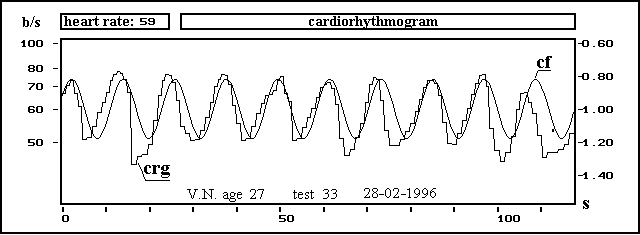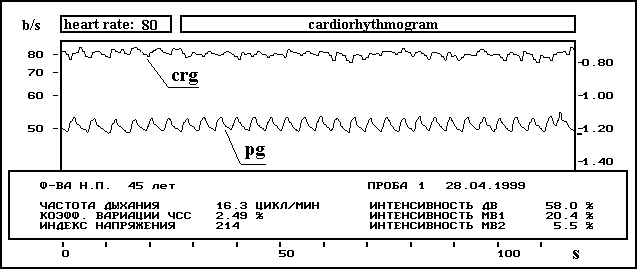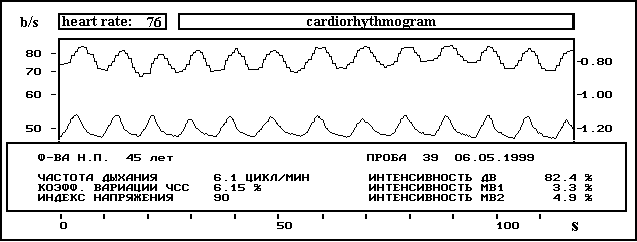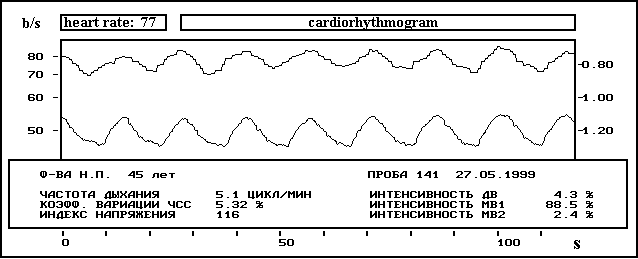 |
||
Suvorov N.B., Frolova N.L.
Russia, St.Petersburg, Institute for Experimental Medicine RAMS, e-mail: iem@iem.spb.ru
INTELLIGENT BIOTECHNICAL SYSTEM FOR HUMAN STATE MODIFICATION
Ñóâîðîâ Í.Á., Ôðîëîâà Í.Ë.
Ðîññèÿ, Ñ.-Ïåòåðáóðã, ÍÈÈÝÌ ÐÀÌÍ, e-mail: iem@iem.spb.ru
ÈÍÒÅËËÅÊÒÓÀËÜÍÀß ÁÈÎÒÅÕÍÈ×ÅÑÊÀß ÑÈÑÒÅÌÀ ÄËß ÊÎÐÐÅÊÖÈÈ ÑÎÑÒÎßÍÈß ×ÅËÎÂÅÊÀ
The present stage in development of medicine is characterized by the amplifying attention to non-pharmacologic methods of treatment and rehabilitation of various pathological states. At the present moment a method of the biofeedback control (BFBC) develops actively as a means of diagnostics and functional correction in the condition of separate systems and organism as a whole. The biofeedback is the complex of research and medical procedures, when the patient by means of an external circuit of the feedback is informed on a condition and change this or that adjustable physiological processes. Visual, acoustical or tactile information allows the selfregulation skills to be developed.
All over the world the BFBC methods use deserved popularity. In clinics the BFBC began to be applied since 60's. Abroad this direction has the name "biofeedback-training". Special journals are issued: "Biofeedback and Selfregulation" (USA) and "Biofeedback. The theory and practice" edited by M.B.Schtark and R.Kall (Russia), publishing results in study of biological systems under conditions of voluntary selfregulation of various physiological functions. In Russia the development of study in the given direction was promoted by researches of N.N.Vassilevsky, O.V.Bogdanov, E.G.Vaschillo, N.B.Suvorov, M.B.Schtark.
The results in researches of neurophysiological mechanisms of physiological functions selfregulation in a biofeedback principle specified necessity to use oscillatory character (periodic inhibitory and activation) of adjustable physiological function. During researches, carried out in the oscillatory mode, specific features of cardiorhythm control were revealed. They were connected to manifestation of maximum cardiorhythmogram (CRG) fluctuations with the determined (own) frequencies. According to the preliminary data the oscillatory BFBC has appeared effective for correction of vegetative disorders and psychosomatic pathology. However, the works mentioned above had a phenomenon character and did not apply on the detection of mechanisms, ensuring positive medical effect of oscillatory cardiotraining, that partly was caused by the fact that the similar purposes by the authors were not put. Modern ideas about selfregulation processes, numerous data appearing in literature about systemic influences on CR and the certain progress in the field of computer technologies allow to set and to solve some new problems studying selfregulation of functions of the cardiovascular system and to create new methods of diagnostics and correction in the state of health and disease.
In research there were 49 neurocirculatory distonia patients of hypertensive, hypotensive and normotensive types with cardial, astheno-neurotic, vasomotorial and respiratory syndrom. They did not accept any pharmacologic preparations during the cycle of cardiotraining. Every cycle consisted of 10 – 20 sessions with 8 two-minutes tests of BFBC; session duration was about an hour. The researches were carried out on the biotechnical system "Cardiotraining", consisting of a ECG-converter, PC and the software. After processing the biofeedback signal was displayed on the monitor in real time as the CRG of a patient, describing the rate of the heart’s beat. Simultaneously sine wave curve as a criterion function (CF) was presented on the screen. Under training the patient had to try to combine two curves – own CRG and CF (Fig.1). The researcher called patient’s attention to interdependence of the CRG-variability and periodicity and amplitude of breath. The quality of tracing was estimated by the amplitude of the main cardiorhythm harmonic, appropriate to the period of the CF and the crosscorrelation factor between the sine curve, CRG and pneumogram (cardiorespiratory synchronization).

Fig. 1 An example of the combining of own cardiorhythmogram and a criterion function.
The software allows in an adaptive automatic mode to make the analysis of data, obtained by mathematical processing of the CRG and some additional parameters (after each test arterial pressure by Korotkoff, processed pulse pressure, average dynamic pressure, stroke volume and minute volume of blood circulation, peripheral resistance and others was fixed in the database). However the basic method of the analysis was determined the spectral analysis of the CRG as frequent parameters even at short-term samples allow to receive the necessary information for physiological interpretation of the heart rate variability. Periods, amplitudes of the main (own) harmonics and the average pulse frequency were basic parameters for formation of the criterion function for the biofeedback training.

A. No cardiorespiratory synchronization in the 1-st test.
Crg – cardiorhythmogram, pg – pneumogram.

B. Cardiorespiratory synchronization (test 39).

C. Cardiorespiratory synchronization at the end of the cycle.
Fig.2 Dynamics of the cardiotraining (tests N 1, 39 and 141) – bronchial asthma.
Electroencephalographic research (19 monopolar channels) was carried out in the beginning and the end of each session. The transducer (using effect by Hall) was applied to registration of thorax respiratory excursions. Oscillatory cardiotraining with an adaptive biological feedback carries out alternate training of regulation mechanisms in the cardiovascular and respiratory systems, that promotes reception of positive clinical results at the expense of expansion of the dynamic range of adaptive oscillatory processes.
The BFBC through the change of the breath pattern helps revealing of the own frequencies and amplification of periodicity of the CRG fluctuations (if central oscillatory activity is not broken), which owing to the spectral analysis are displayed as own harmonics having higher amplitude. The cardiotraining efficiency depends on conformity of the own fluctuations period to parameters of the criterion functions. Accordingly, two biofeedback upgrades are developed: I – the adaptive mode in the first tests and further biocontrol with the criterion functions, as much as possible appropriate to own CRG periods; II – synchronization of the respiratory movements with own CRG-fluctuations. Such application has given the best clinical results.
It is revealed also three types of the CRG: 1-st type – the CRG with localization of the main harmonic, according to own CRG frequency in the field of slow waves (Fig.2); 2-nd type – with localization of the main harmonic in the field of fast waves; 3-rd type – the absence of the main harmonics in the CRG. It is established, that the period of the main harmonics is more, the adaptive plasticity of the CRG is higher. It is determined the conditions, at which there is the change of types and period of the main harmonics in the CRG.
The effective BFBC produces the following changes in the CRG: formation of the main harmonics at initial 3-rd type of the CRG; increase of the amplitude and period of the main CRG harmonics. This is accompanied by improvement of the clinical state of patients.
The synchronization of the respiratory movements with the CRG fluctuations promotes the amplification of synchronizing processes in slow bioelectrical activity of the brain (EEG), that specifies the activation of integrative processes at an intersystem level of regulation and control.
| Site of Information
Technologies Designed by inftech@webservis.ru. |
|